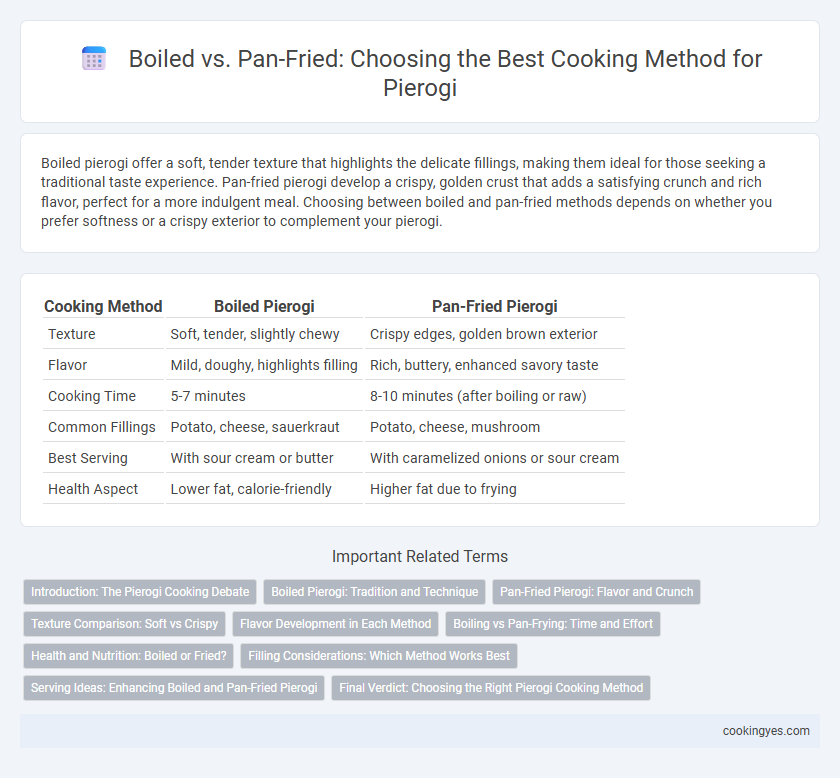Boiled pierogi offer a soft, tender texture that highlights the delicate fillings, making them ideal for those seeking a traditional taste experience. Pan-fried pierogi develop a crispy, golden crust that adds a satisfying crunch and rich flavor, perfect for a more indulgent meal. Choosing between boiled and pan-fried methods depends on whether you prefer softness or a crispy exterior to complement your pierogi.
Table of Comparison
| Cooking Method | Boiled Pierogi | Pan-Fried Pierogi |
|---|---|---|
| Texture | Soft, tender, slightly chewy | Crispy edges, golden brown exterior |
| Flavor | Mild, doughy, highlights filling | Rich, buttery, enhanced savory taste |
| Cooking Time | 5-7 minutes | 8-10 minutes (after boiling or raw) |
| Common Fillings | Potato, cheese, sauerkraut | Potato, cheese, mushroom |
| Best Serving | With sour cream or butter | With caramelized onions or sour cream |
| Health Aspect | Lower fat, calorie-friendly | Higher fat due to frying |
Introduction: The Pierogi Cooking Debate
Boiled pierogi offer a traditional texture with a soft, tender dough that evenly cooks the filling, preserving moisture and flavor. Pan-fried pierogi develop a golden, crispy exterior, adding a contrasting crunch that enhances the taste experience. Choosing between boiling and pan-frying depends on desired texture and presentation, with many cooks opting to boil first and then pan-fry for a balanced outcome.
Boiled Pierogi: Tradition and Technique
Boiled pierogi represent the traditional cooking method, preserving the dough's soft and tender texture while allowing fillings like potato, cheese, or sauerkraut to remain moist and flavorful. This technique involves simmering pierogi in salted water until they float, signaling perfect doneness without overcooking or splitting. Boiling enhances the authentic Polish culinary experience by maintaining the classic balance between delicate dough and rich, hearty fillings.
Pan-Fried Pierogi: Flavor and Crunch
Pan-fried pierogi develop a distinctive golden-brown crust that enhances both texture and flavor, creating a satisfying crunch with every bite. The Maillard reaction during pan-frying intensifies the savory notes of the dough and filling, elevating traditional recipes. This method locks in moisture while adding a crispy exterior, making pan-fried pierogi a popular choice for those seeking a rich and texturally complex dish.
Texture Comparison: Soft vs Crispy
Boiled pierogi have a tender, soft texture that retains moisture and highlights the creamy filling, offering a delicate bite. Pan-fried pierogi develop a crispy, golden-brown exterior while maintaining a slightly chewy interior, creating a contrast in textures. This cooking method choice impacts the overall mouthfeel, with boiled pierogi being smooth and comforting, and pan-fried pierogi delivering a satisfying crunch.
Flavor Development in Each Method
Boiling pierogi preserves their soft, tender texture and highlights the fillings' inherent flavors without additional fat, making it ideal for showcasing fresh ingredients like potatoes or cheese. Pan-frying pierogi after boiling creates a crispy, golden crust that enhances flavor through Maillard reactions, adding a rich, savory dimension and a satisfying contrast in texture. Combining both methods offers a balanced flavor profile with tender interiors and flavorful, crunchy exteriors that appeal to diverse taste preferences.
Boiling vs Pan-Frying: Time and Effort
Boiling pierogi typically takes 5 to 7 minutes and requires minimal effort, simply waiting for them to float to the surface before removal. Pan-frying pierogi adds a crispy texture and takes around 10 to 12 minutes, involving more active attention to flipping and monitoring heat. Choosing boiling offers a quicker, hands-off cooking method, while pan-frying demands extra time but enhances flavor with a golden, crunchy exterior.
Health and Nutrition: Boiled or Fried?
Boiling pierogi retains more nutrients and reduces fat content, making it a healthier cooking method compared to pan-frying, which introduces additional oils and increases calorie intake. Pan-fried pierogi tend to have higher fat levels and may contain trans fats depending on the cooking oil used, impacting heart health. For a balanced diet, boiled pierogi offer a lower-calorie option while preserving essential vitamins and minerals.
Filling Considerations: Which Method Works Best
Boiling pierogi is ideal for delicate fillings like cheese, potato, or sauerkraut, as it preserves moisture and keeps the dough tender without overcooking the interior. Pan-frying enhances pierogi with firmer fillings such as meat or mushrooms by creating a crispy exterior while maintaining the filling's texture and flavor. Choosing the cooking method depends on the filling's moisture content and desired texture to achieve optimal taste and mouthfeel.
Serving Ideas: Enhancing Boiled and Pan-Fried Pierogi
Boiled pierogi offer a soft and tender texture ideal for toppings like sour cream, sauteed onions, and crispy bacon bits, enhancing their creamy filling. Pan-fried pierogi develop a golden, crispy exterior that pairs perfectly with garnishes such as caramelized onions, melted cheese, or a drizzle of garlic butter for added richness. Serving boiled pierogi with fresh herbs and pan-fried ones with crunchy toppings creates diverse flavor profiles that elevate the traditional dish.
Final Verdict: Choosing the Right Pierogi Cooking Method
Boiling pierogi results in a tender, soft texture that preserves the delicate dough and fillings, ideal for traditional recipes with creamy or savory interiors. Pan-frying after boiling creates a crispy, golden exterior that adds a delightful contrast and enhances flavor through caramelization. Selecting the right cooking method depends on the desired texture and taste profile, with boiling preferred for softness and pan-frying favored for extra crunch and richness.
Boiled vs Pan-Fried for Pierogi Cooking Method Infographic

 cookingyes.com
cookingyes.com